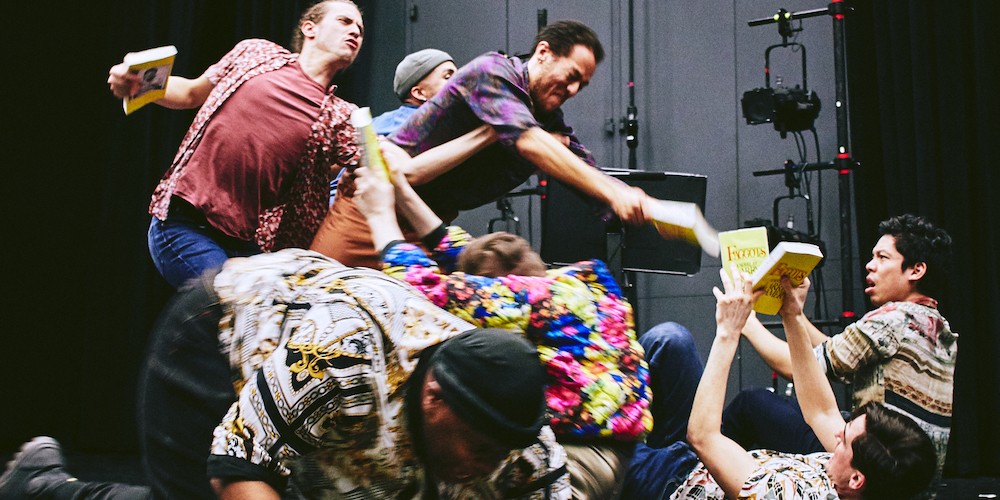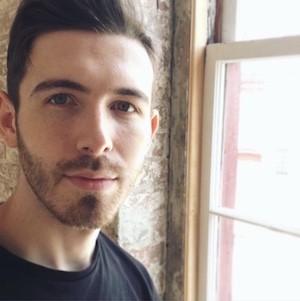Theatre in Motion: Directing Across Disciplines with Kevin Carillo
In Theatre in Motion, we discuss theatre's movement across stages, through time, and within communities with its creators and practitioners.
We talked about merging disciplines, finding one’s creative voice, and devising work with Directing student Kevin Carillo.
Kevin Carillo is a theater director/choreographer based in NYC. Last winter, for his graduate thesis at Columbia University, he conceived figaro/faggots, a new opera-theater hybrid work with music by W.A. Mozart and text by Larry Kramer. Kevin is Co-Director of UNCENSORED at MCC Theater, an annual devised production with NYC teens. Awards/Fellowships: William R. Kenan, Jr. Fellowship at Lincoln Center; the 2019 Director Assistantship at Williamstown Theater Festival, where he worked with Trip Cullman; Directing Fellow Pool at Manhattan Theater Club; lead artist residency at the Mercury Store (Fall 2022 and Spring 2023). He apprenticed with Ivo van Hove at Internationaal Theater Amsterdam on Gevechten en Metamorfosen van been Vrouw by Edouard Louis. Kevin holds a BFA in Drama from University of North Carolina School of the Arts (Kenan Excellence Scholarship)and will soon complete his MFA in Theatre Directing at Columbia University under the guidance of Directing Concentration Head and Professor Anne Bogart, Theatre Department Chair and Professor Brian Kulick, and Guest Lecturer Katie Mitchell.
Can you tell me about your personal theatre history?
Kevin Carillo: I started theatre in preschool. My class had gone on a field trip to see The Wizard of Oz: On Ice. I was completely hooked by the form of the event, including the school bus we took to get to the ice rink. So, I recreated that experience inside my classroom during self-structured play-time. I lined up chairs and had my classmates and preschool teacher sit as though they were on a bus, then had them change their direction when we “arrived at the rink” to watch the show—which I directed—starring a small company of my fellow four-year olds.
Growing up, I loved movement and was enrolled in dance classes. While in middle school, I worked on a show that was choreographed by Susan Stroman and directed by Mike Ockrent. It was my first professional experience and I was performing a track that was quite active in the ensemble. There were wonderful dance numbers, but what was most thrilling to me was a “street scene" where the choreography was an intricate staging of people trafficking a busy London street on Christmas Eve. Everything was timed specifically to music and lyrics, and yet looked so natural. I wanted to figure out how that was technically achieved. It was one of the first conscious experiences I had that sort of signaled to me I wanted to be a director-choreographer.
During high school and undergrad, I was in search of a way to speak that wasn't solely by verbal language. I found inspiration from choreographer Pina Bausch who I felt was expertly speaking through metaphor. She was, from what I observed, contextualizing movement and bodies with costumes, scenery, and objects—which all felt very theatrical.
With those various inspirations, what did your undergraduate and pre-Columbia experience look like?
KC: I attended the School of Drama at the University of North Carolina School of the Arts (UNCSA). They run a very physical conservatory program; it involves mask work and a rigorous voice department—which is something I also think of as physical. I think the voice has the capability of dancing. I loved being there, and was hungry to fill my downtime with more learning, so I received permission from the then-Dean of the School of Dance, Susan Jaffe, to join men's class in the Ballet Department every morning.
Following UNSCA, I had a fellowship at Lincoln Center in their education department, during which I created a dance theatre piece that was a one person work. I was that “one” person. In the process, I discovered that I was at a crossroads between wanting to be inside of the “thing” and also wanting to view all of the elements that create it. That tension signaled to me again that I might be a director. While I was at Lincoln Center, I was also interning in the Education Department at MCC Theater and working with their Youth Company. MCC has a program for high school students from all five boroughs who are interested in theatre, which culminates in the devising and presentation of a work called UNCENSORED. That work is entirely written by this company of students and then shaped in collaboration with the Performance Lab Directors and Education staff.
Working on UnCensored is a devising experience. It starts with a piece of text that a company member has written, and then we enter the rehearsal room without any expectation of what we'll find or what we'll make. The process is incredibly fast. It really pushes everyone to let go of any inhibitions and to try throwing spaghetti at the wall to see what sticks. I found that discovering movement with a young person around words that they had written was something that I was passionate about. Shortly after interning at MCC, I began assistant directing off-Broadway plays that were more traditional in their conventions for storytelling. It became clear what I was wanting, and the reason I pursued theatre in the first place, was to find a new and more effective way to personally communicate. I came to Columbia in search of the time and space to discover what I needed to say and how I might say it.
What does your directing process look like? I am interested in hearing how your process, as both a trained actor and dancer, might involve physicality in addition to text-focused work. Do you ever encounter a sort of “language barrier” with actors who have less experience in movement?
KC: I think the only barrier is people's willingness to try something new or different. With every project, I always begin with table work, and I think it’s important to do that, but I dread staying seated too long. I think it’s also valid to learn about a play and its characters through physicalization. My process aims to find a new balance for the rehearsal of all theatrical elements. I have a technique that allows performers to hop up into the space and to hear the text as they begin to physicalize it—which requires no memorization. I do this exercise a number of times, and each repetition begins to have a different focus. The first pass of improvisation might center around what is being said, meaning the content of the text. The next improvisations are often around rhythm, melody, and the tone of the verbal language. Through the actor's impulses, we build a behavioral dance together that is in-time with the text, treating it as though it were a piece of music.
Speaking of merging or working across disciplines, I know you’ve also worked creatively to merge seemingly disparate artists. Recently, you’ve made a connection in your work between Mozart and Larry Kramer. What led you to both artists individually and how did you bring them together?
KC: I took inspiration again from Pina Bausch: one of her first projects was called Barbe Bleue, or Bluebeard in English, from the Bartók opera, Duke Bluebeard’s Castle. The backstory that I've heard was that Bausch was commissioned to stage the opera, but she didn't love working with the conductor or the singer that the operahouse had chosen. Instead of pursuing that collaboration, she decided to play a vinyl recording of the music alongside her company of dancers. When I watch that piece, I can see her grappling with the material of the opera, the sound and content, and expressing her thoughts through a language of physical metaphor and imagery. I can spot the aesthetic seeds she was planting in this first piece which would eventually develop and grow as the artistic voice in all her later work.
Following in Pina’s footsteps, I wanted to give myself a similar opportunity—or challenge. In a class where Katie Mitchell served as guest lecturer, I had been working on a project around Mozart's Le Nozze di Figaro, or The Marriage of Figaro. I was recontextualizing the opera to encompass same-sex marriage, and I was in search of something that felt like documentary material from the 1970s—post-Stonewall and Gay Liberation, but before the AIDS epidemic—to retrofit the libretto. I stumbled upon the writings of playwright, author, and activist Larry Kramer. His writing was urgent, bold, and loud; the conversation he wrote into in his numerous works resonated with my present life circumstances and I felt that, through Kramer’s texts, I found the words to express questions I had been grappling with myself.
There are a lot of similarities between the Mozart and Kramer texts. They both have active, sprawling plots which were irreverent and full of satire, and they were also groundbreaking in form and subject, especially for the times in which these artists were creating. The project became a really beautiful marriage of these two artists. As I've worked on it, I've just been open to discovering how both sources of material respond to each other. My plans and expectations for what the project was going to be were delightfully challenged, and it became something of its own entirely. My rehearsals mimicked the devising I do at MCC, where I listen intensely for the thing that's going to make the hairs on my arms stand up. And when they do, I race towards the combination of choices that created the sensation. I've often learned that my imagination doesn't operate with the same physical principles as reality, and I need to contend with gravity each time I'm in a space with performers. Sometimes the things that you think will work, however simple they may be, don't. And the surprises that emerge from the rehearsal room, that I never considered intellectually, are great complications to my questions and often reveal artistic solutions.
As a theatre-goer, what moves you and makes you keep going to the theatre?
I love when I am met as an audience member with a work that is daring, unabashedly itself, and desperately trying to communicate through form as rigorously as the textual argument it's expressing. Theatre is a physical medium and it has many elements that create it—and text is just one of those elements. I find I’m often moved when I see a work where two voices are speaking at the same time: one is the text or story, and the other is the way the performers are physically responding by either contradicting or complementing that text. Seeing two different things simultaneously gives me an active job of connecting the dots between two potentially disparate elements—subsequently allowing me the room to interpret and create meaning in the space between them. I love when I get to experience the world of meaning-making that happens inside of a work. When that happens, theatre feels like an event; it feels like I'm a witness to something that's happening, and I am a necessary part. As a witness, I have an active role and the thing isn't complete—or perhaps it's never complete, but the thing isn't made—until I've put in work and reflection around what I've seen.

